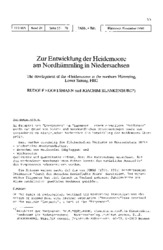Zur Entwicklung der Heidemoore am Nordhümmling in Niedersachsen
Eggelsmann, Rudolf; Blankenburg, Joachim, 1990: Zur Entwicklung der Heidemoore am Nordhümmling in Niedersachsen. In: TELMA - Berichte der Deutschen Gesellschaft für Moor- und Torfkunde, Band 20: 55 - 78, DOI: 10.23689/fidgeo-3228.
 |
Dokument öffnen: |
Am Beispiel des "Leegmoores" im Timpemoor - einem ehemaligen "Heidemoor" - wurde auf Grund von boden- und moorkundlichen Untersuchungen sowie von landeskundlich-historischen Recherchen die Entwicklung der Heidemoore überprüft.
Dazu wurden erstmalig die flächenhaften Verluste an Moorsubstanz durch
- wiederholte Moorbrandkultur,
- Entnahme von Heidesoden (Abplaggen) und
- Winderosion
qualitativ und quantitativ erfaßt, dazu die Moorsackung errechnet. Aus den vorhandenen moorkundlichen Fakten konnte das natürliche Moorrelief des Timpemoores rekonstruiert werden. Die Autoren weisen nach, daß die von JONAS (1934, 1935) beschriebenen Heidemoore "durch den Menschen beeinflußte Moore" darstellen. Das untersuchte Timpemoor hat sich danach im Verlauf mehrerer Jahrhunderte aus einem natürlichen gewölbten Hochmoor gebildet. On the basis of pedological, peatland and historical investigations the origin of raised bogs with heather vegetation ("Heidemoore")was examined at the example "Leegmoor", a part of the "Timpemoor". In addition to that for the first time the loss of peat substance by
- burnt-over peatland cultivation,
- cutaway heather sods,
- erosion by wind and
- bog subsidence
was calculated. With the available peatland facts it was possible to reconstruct the natural bog relief. The authors are able to demonstrate that the "Heidemoore" described by JONAS (1934, 1935) are bogs influenced by man. During the last centuries the Timpemoor developed from a natural raised bog (with convex centre) to a raised bog with heather vegetation.

